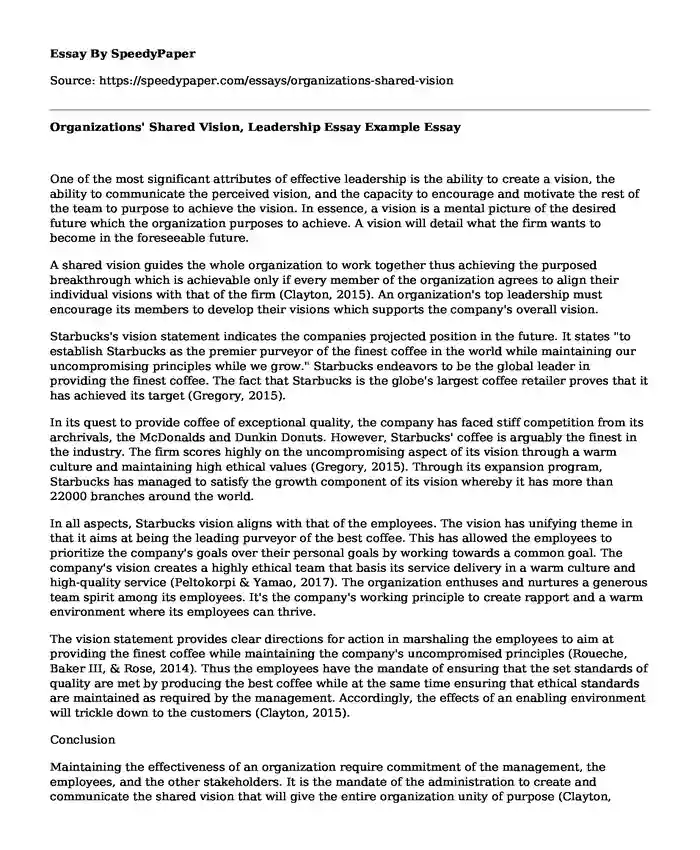
| Type of paper: | Essay |
| Categories: | Leadership analysis Organizational behavior |
| Pages: | 3 |
| Wordcount: | 642 words |
One of the most significant attributes of effective leadership is the ability to create a vision, the ability to communicate the perceived vision, and the capacity to encourage and motivate the rest of the team to purpose to achieve the vision. In essence, a vision is a mental picture of the desired future which the organization purposes to achieve. A vision will detail what the firm wants to become in the foreseeable future.
A shared vision guides the whole organization to work together thus achieving the purposed breakthrough which is achievable only if every member of the organization agrees to align their individual visions with that of the firm (Clayton, 2015). An organization's top leadership must encourage its members to develop their visions which supports the company's overall vision.
Starbucks's vision statement indicates the companies projected position in the future. It states "to establish Starbucks as the premier purveyor of the finest coffee in the world while maintaining our uncompromising principles while we grow." Starbucks endeavors to be the global leader in providing the finest coffee. The fact that Starbucks is the globe's largest coffee retailer proves that it has achieved its target (Gregory, 2015).
In its quest to provide coffee of exceptional quality, the company has faced stiff competition from its archrivals, the McDonalds and Dunkin Donuts. However, Starbucks' coffee is arguably the finest in the industry. The firm scores highly on the uncompromising aspect of its vision through a warm culture and maintaining high ethical values (Gregory, 2015). Through its expansion program, Starbucks has managed to satisfy the growth component of its vision whereby it has more than 22000 branches around the world.
In all aspects, Starbucks vision aligns with that of the employees. The vision has unifying theme in that it aims at being the leading purveyor of the best coffee. This has allowed the employees to prioritize the company's goals over their personal goals by working towards a common goal. The company's vision creates a highly ethical team that basis its service delivery in a warm culture and high-quality service (Peltokorpi & Yamao, 2017). The organization enthuses and nurtures a generous team spirit among its employees. It's the company's working principle to create rapport and a warm environment where its employees can thrive.
The vision statement provides clear directions for action in marshaling the employees to aim at providing the finest coffee while maintaining the company's uncompromised principles (Roueche, Baker III, & Rose, 2014). Thus the employees have the mandate of ensuring that the set standards of quality are met by producing the best coffee while at the same time ensuring that ethical standards are maintained as required by the management. Accordingly, the effects of an enabling environment will trickle down to the customers (Clayton, 2015).
Conclusion
Maintaining the effectiveness of an organization require commitment of the management, the employees, and the other stakeholders. It is the mandate of the administration to create and communicate the shared vision that will give the entire organization unity of purpose (Clayton, 2015). The shared vision should have a compromise between the employees' vision and the organization's vision to avoid any rebellion from the workers. This is achieved by recognizing the role played by each employee in the organization structure and allow for the free flow of information among the members. Summarily, a shared vision will propel an organization to greater heights than a partisan vision.
References
Clayton, B. C. (2015). Shared vision and autonomous motivation vs. financial incentives driving success in corporate acquisitions. Frontiers in psychology, 5, 1466.
Gregory, L. (2015). Starbucks Coffee's Vision Statement & Mission Statement. Retviered from http://panmore. com/starbucks-coffee-vision-statement-missionstatement.
Peltokorpi, V., & Yamao, S. (2017). Corporate language proficiency in reverse knowledge transfer: A moderated mediation model of shared vision and communication frequency. Journal of World Business, 52(3), 404-416.
Roueche, P. E., Baker III, G. A., & Rose, R. R. (2014). Shared vision: Transformational leadership in American community colleges. Rowman & Littlefield.
Cite this page
Organizations' Shared Vision, Leadership Essay Example. (2022, Feb 25). Retrieved from https://speedypaper.com/essays/organizations-shared-vision
Request Removal
If you are the original author of this essay and no longer wish to have it published on the SpeedyPaper website, please click below to request its removal:
- The Social Construction of Gender, Free Essay in Sociology
- Compare and Contrast Essay Sample on National and Nevada Governments
- Fear and Loathing of the English Passive, Free Essay for Students
- Free Essay: Impacts That Nursing Leaders Have in an Organization Growth in a Skilled Nursing Care
- Securities and their Valuation - Business Plan Essay Sample
- Free Essay on Sports Facility Management
- Essay Sample on Role of Free Higher Education
Popular categories




